In mid-July 2023 the media were full of reports of record breaking temperatures in southern Europe. But were the temperatures really exceptional?
Here I examine the data for seven locations from Spain to Turkey to address this question.
Be aware throughout that, until 2021, the accepted European record temperature was 48.0oC set in Greece on 10 July 1977 – yes, that long ago. It was broken on 11 August 2021 by a temperature of 48.8oC in Sicily.
The July 2023 temperatures did not set a new European record, despite the media hype.
Data Sources
I have used two sources of data. For temperatures from 1900 to 2020 (or for whatever subset of that range data were available) I used, https://www.ecad.eu/indicesextremes/customquerytimeseriesplots.php. This is the website of the European Climate Assessment & Dataset (ECA&D) project. It states that the site presents “information on changes in weather and climate extremes, as well as the daily dataset needed to monitor and analyse these extremes”. It appears to have solid credentials.
This site provides a wide range of options. I have two: (i) the annual maximum of the daily maximum temperatures (i.e., the peak temperature in the year at the given location), and, (ii) the annual average of the daily mean temperatures (i.e., the average temperature over the whole year at the given location). Data was given to two decimal places of oC (but that does not imply accuracy to two decimal places).
As requested I acknowledge Klein Tank, A.M.G. and Coauthors, 2002, Daily dataset of 20th-century surface air temperature and precipitation series for the European Climate Assessment, Int. J. of Climatol., 22, 1441-1453. Data and metadata available at http://www.ecad.eu
For data in years 2021, 2022 and up to July 2023 I used https://www.timeanddate.com/weather/. This site provides the maximum temperature in a given month. To identify the maximum for the year I looked at months from May to September and used the highest. These data are given only to the nearest oC.
I assume that both sites provide “surface air temperature”, usually 2m above the ground (hence, temperature in the shade) as this is the conventional measure, though the latter site does not say so (but the ECA&D source does).
Spain
Madrid
Figure 1 shows the annual peak temperatures in Madrid from 1900 to July 2023, from three different weather stations. Figure 2 shows the annual average temperatures. There is a statistically significant upward trend in both, the gradient for the average temperature being 2.3oC/century. This is (qualitatively) what would be expected if increasing global average temperatures were manifest locally in this city.
(NB: My use of a linear trend since 1900 is merely for ease and convenience. It does not imply that I think warming started in 1900 nor that it necessarily has a constant gradient).
The peak temperature in Madrid in July 2023 was, according to my stated sources, 39oC, and this falls in line with the trend and its scatter. The peak temperature in Madrid was higher in 2022, 2021, 2019, 2018 and 2017. In fact there have been 14 earlier years that saw peak temperatures in Madrid exceed that in 2023 (at least so far, to 30 July’23). The earliest such year was 1966.
Figure 1

Figure 2
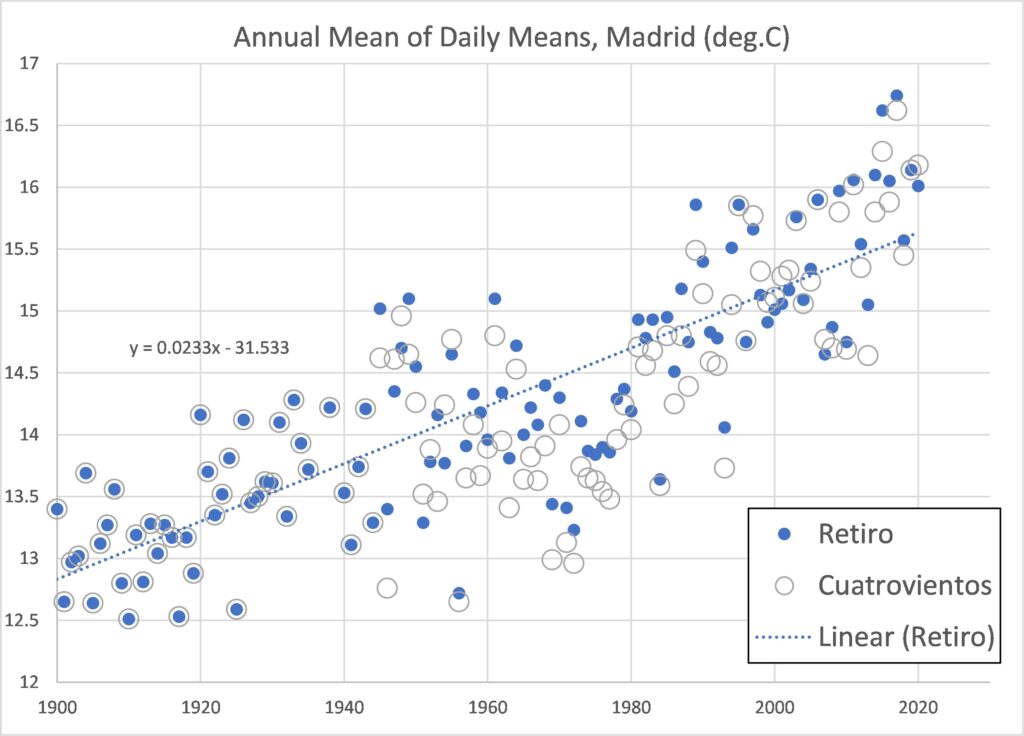
Alicante
Figures 3 and 4 show the peak and annual averaged temperatures in Alicante, Spain, from 1900 to July 2023. There is no statistically significant trend in the peak temperatures. The peak temperature in 2023, up to 30 July, was below the mean of the peak temperatures since 1900. There is a statistically significant trend in the annual averaged temperature, with a gradient of 1.4oC/century.
Figure 3
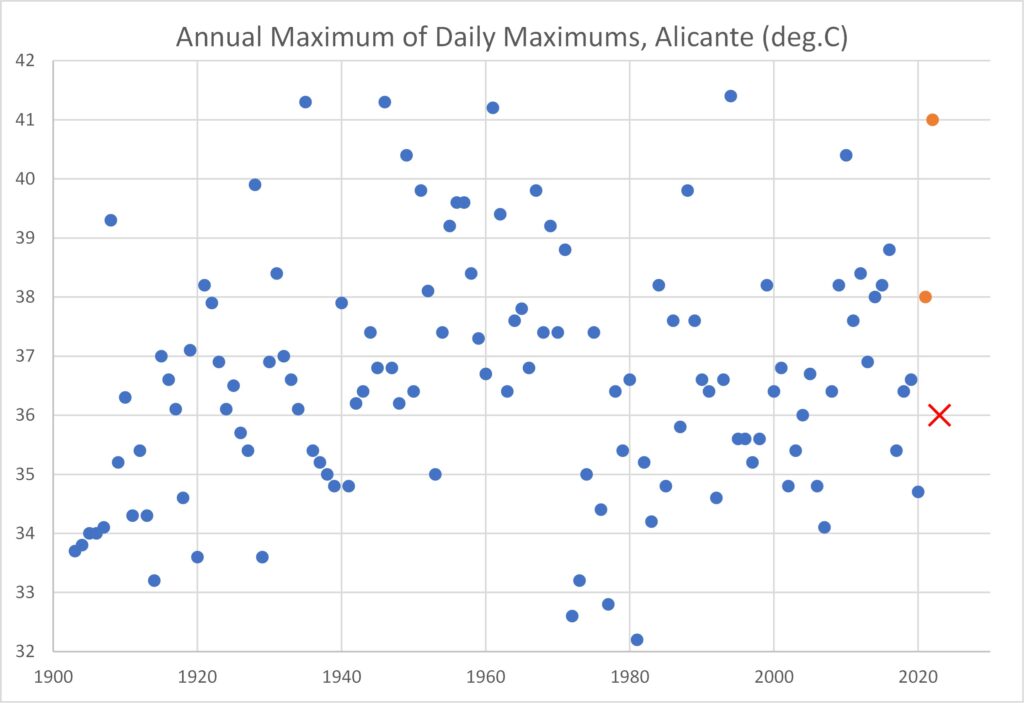
Figure 4
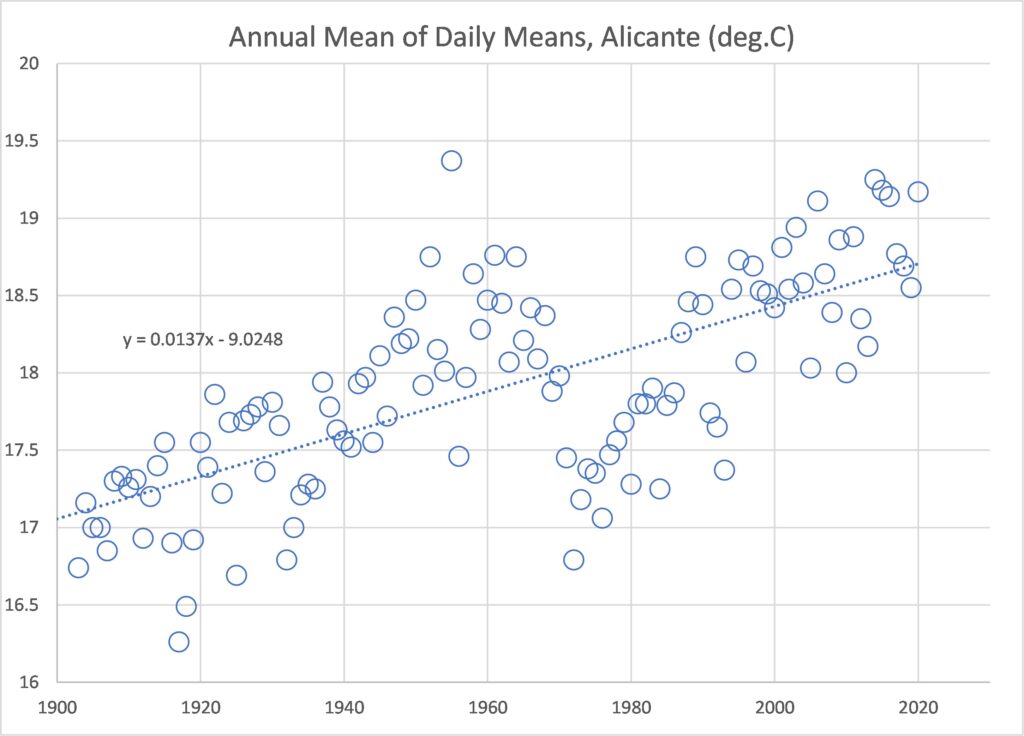
Barcelona
Figures 5 and 6 show the peak and annual averaged temperatures in Barcelona, Spain, from 1900 to July 2023. There is a statistically significant trend in the peak temperatures with gradient 1.8oC/century. However, the 2023 peak temperature (to 30 July) is below the mean trend line, i.e., Barcelona usually has higher peak temperatures. The annual averaged temperatures also have a statistically significant trend upwards, perhaps especially after about 1970.
Figure 5

Figure 6
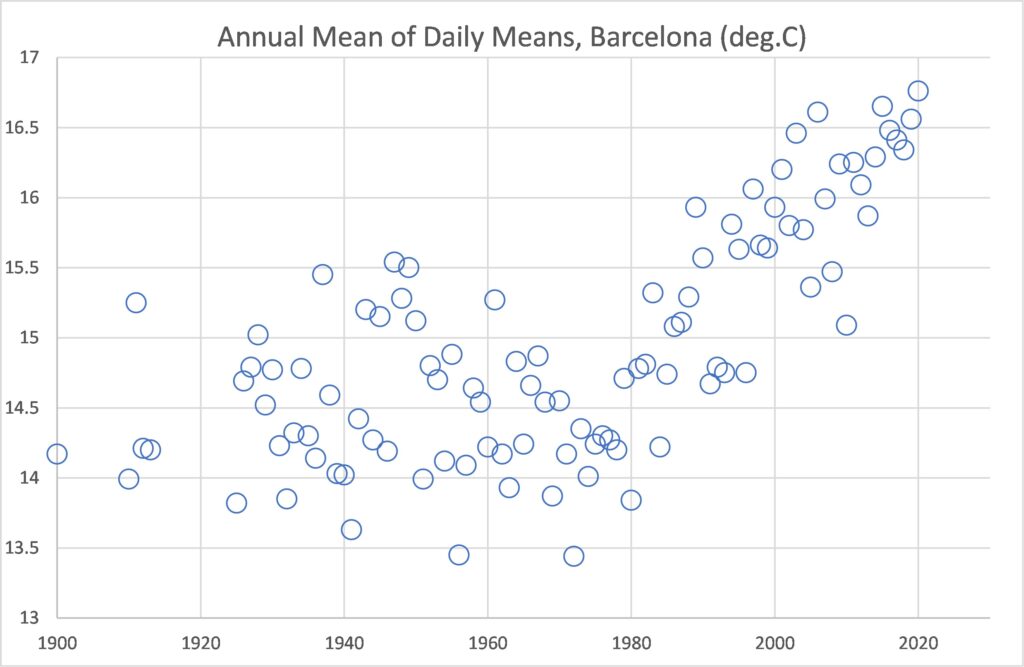
Athens
Athens is one of the hottest places in Europe in summer. Figure 7 shows the annual peak temperatures from 1900 to July 2023. There is no statistically significant trend. The peak temperature in 2023 (up to 30 July) was 42oC. This is not exceptional. There have been 6 years when the peak temperature in Athens exceeded that, the earliest being in 1916. There have been a further 9 years when the peak temperature equalled that in July’23 (i.e., 42oC), the earliest being 1911. The annual averaged temperatures have a statistically significant upward trend of 1.0oC/century.
Figure 7
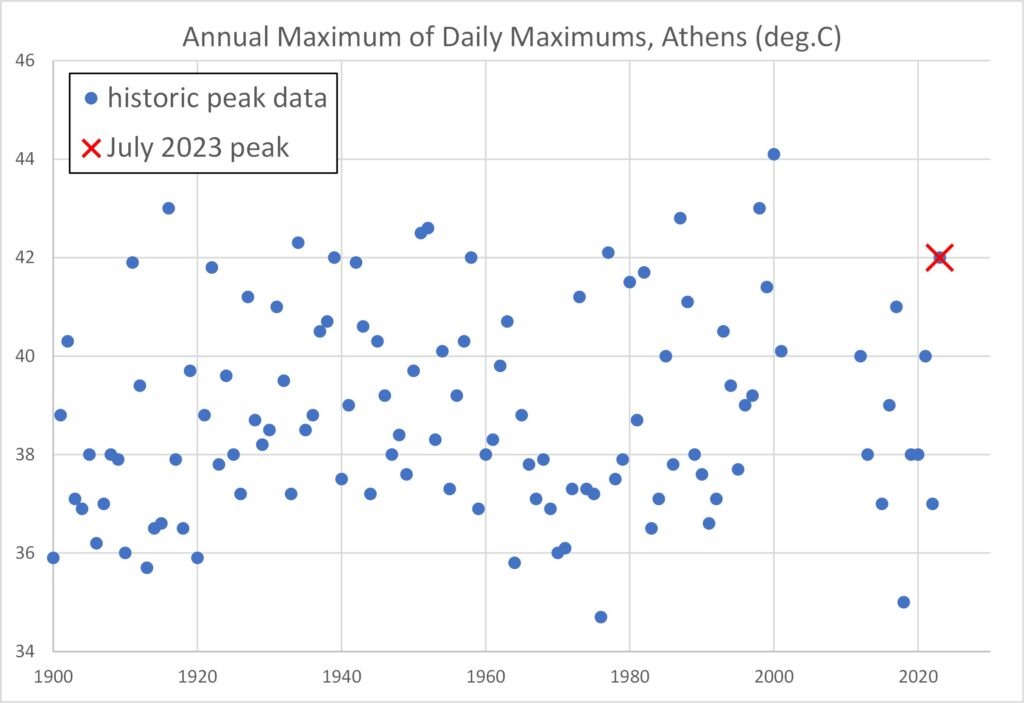
Figure 8

Marseille
I have included Marseille as representative of the south of France. Figure 9 plots the annual peak temperatures there. There is a statistically significant upward trend with gradient 1.5oC/century. The peak temperature so far in 2023 is in line with the mean trend. There is a similar upward trend in the mean data, Figure 10.
Figure 9
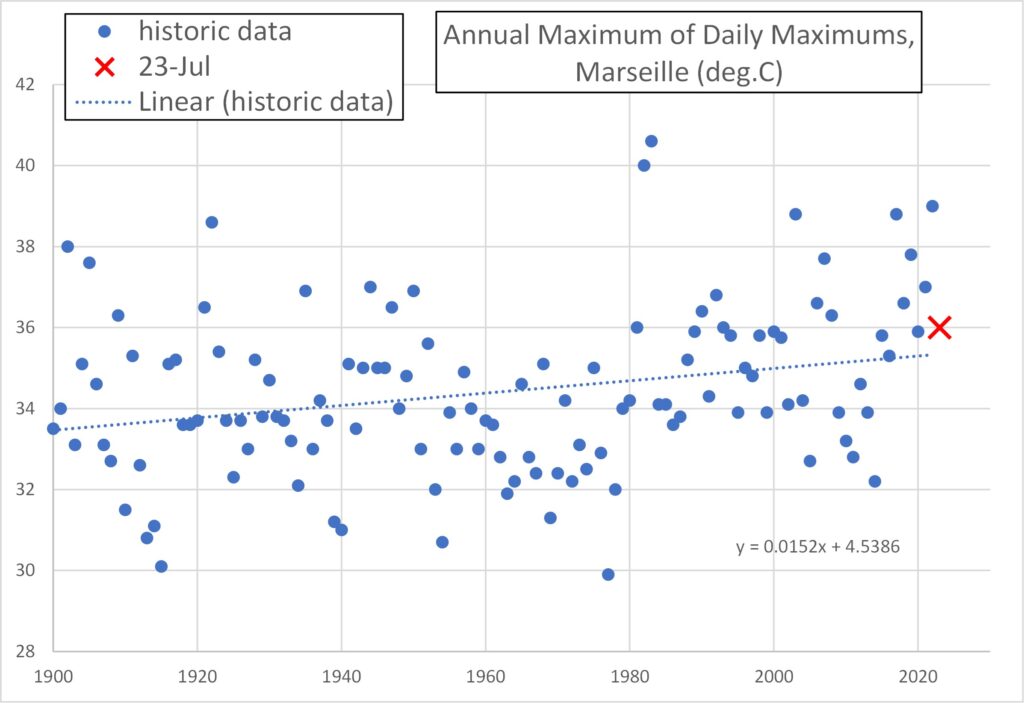
Figure 10
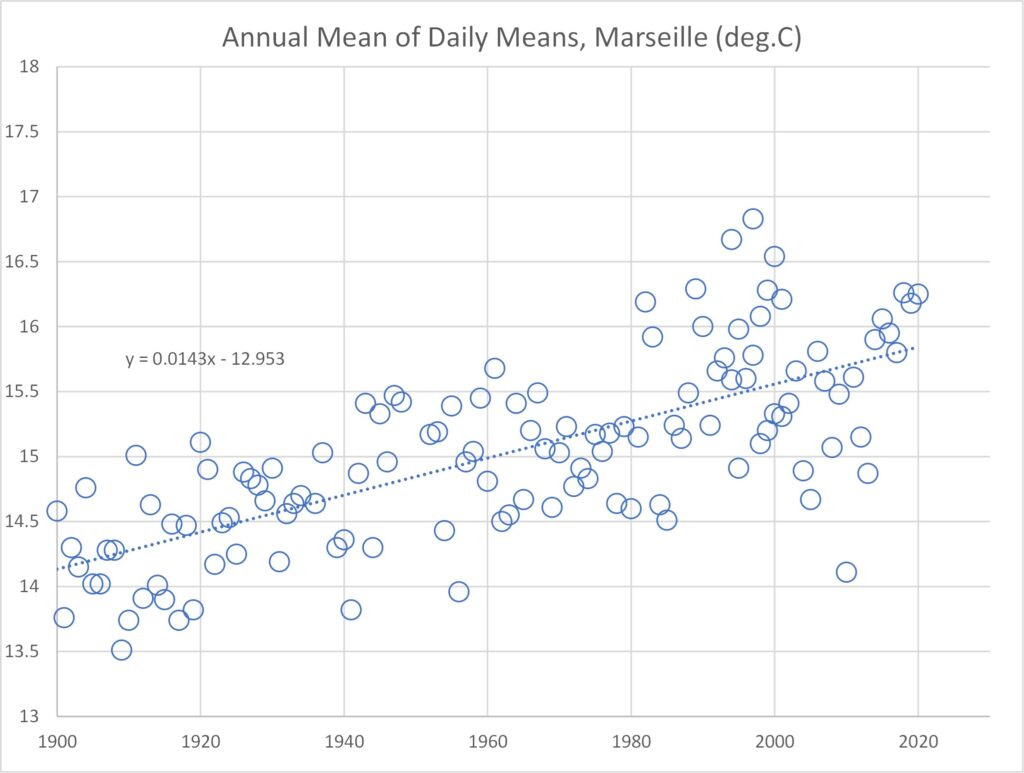
Rome
Rome received a great deal of attention in the media, it being claimed it was heading for a new record. That did not occur. Figure 11 plots the annual peak temperatures from 1951 (the earliest available from my sources). I have plotted separately all six weather stations providing data for Rome. This is of interest because it shows how variable are the results even for locations within the same city. Is this genuine local variation, or an indication of limited accuracy of the data? I don’t know. There is a statistically significant upward trend with a slope of 3.5oC/century. Nevertheless, the peak temperature in 2023 (to 30 July) was far from a new Rome record. There have been 6 years with peak temperatures greater than that, the earliest being 1981. The annual averaged temperatures, Figure 12, also show a statistically significant upward trend with gradient 2.5oC/century.
Figure 11
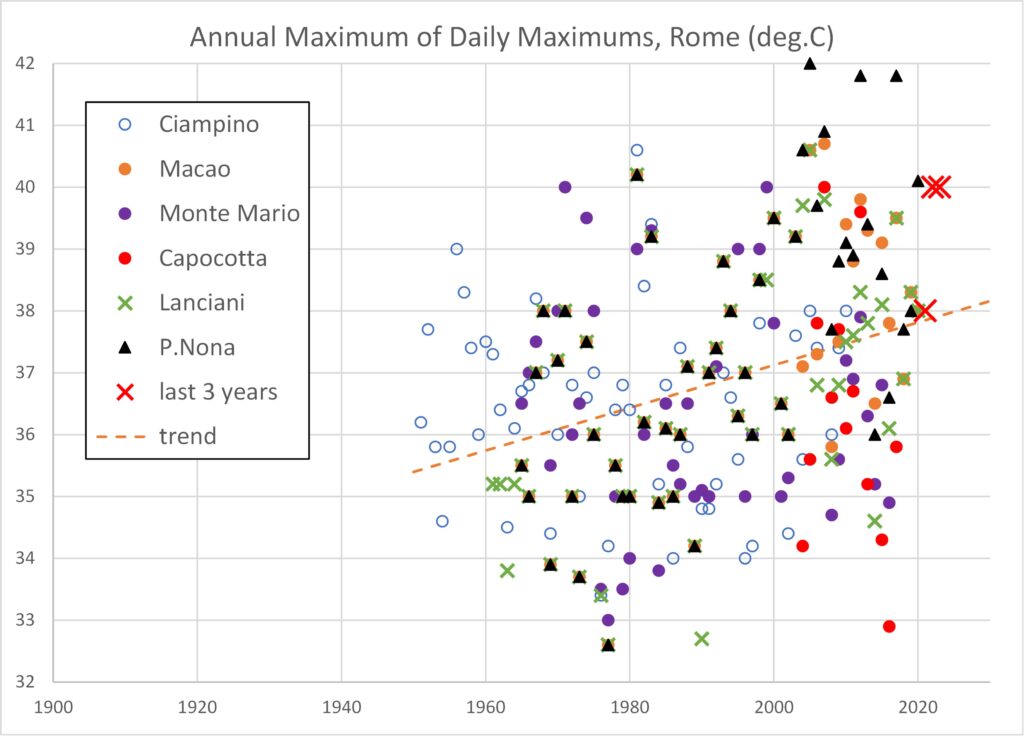
Figure 12

Adana, Turkey
Adana is within the European sector of Turkey, 22 miles inland from the Mediterranean coast. Figures 13 and 14 plot the peak and annual averaged temperatures from 1930 to July 2023. There is no statistically significant trend in the peak temperatures. The peak in July 2023 (41oC) was very average for the city. There is a statistically significant upward trend in the annual averaged temperatures, with gradient 1.1oC/century.
Figure 13
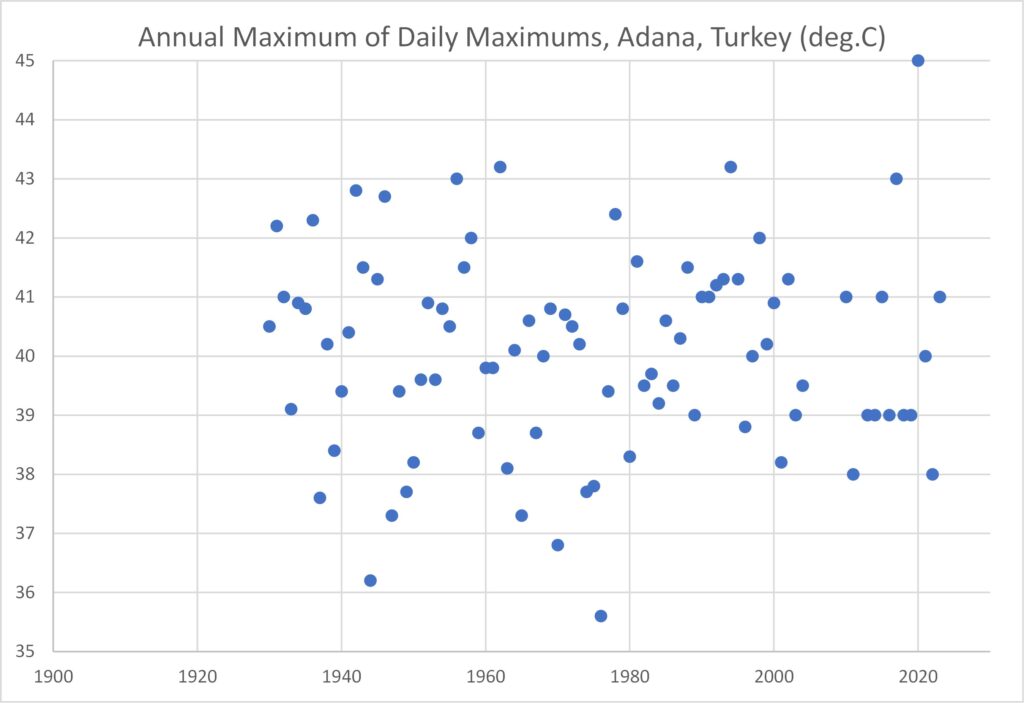
Figure 14
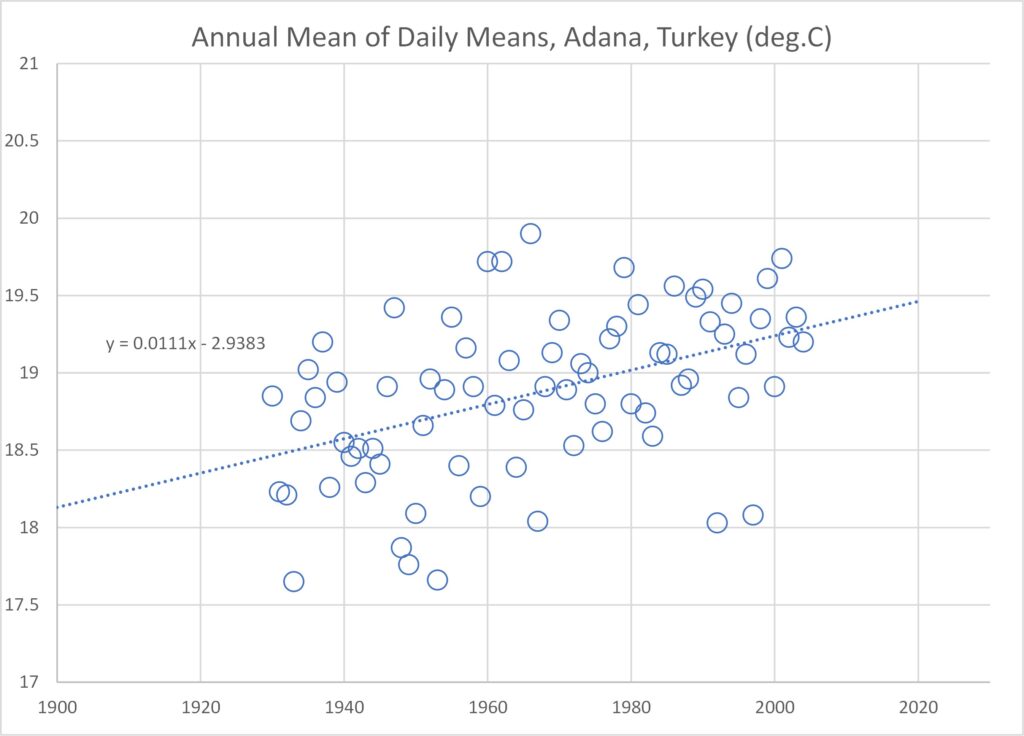
Conclusions
- The hyperbolic reporting of the July’23 heatwave in southern Europe failed to put the temperatures into context. Whilst it is possible that some locations might have experienced a record temperature, none of the seven cities examined here did so (despite some media claims to the contrary), nor was the European record broken. In the seven cities examined the peak temperatures in 2023 (to 30 July) were all within the range of expectation based on the trends over the last several decades.
So, were the July 2023 temperatures in southern Europe exceptional? No.
Nevertheless…
- Some annual peak temperatures showed statistically significant increasing trends over the long term (Madrid, Barcelona, Marseille, Rome) whilst others did not (Alicante, Athens, Adana).
- However, all seven locations showed a statistically significant upward trend in the annual averaged temperatures. Hence, an increase in average temperature does not always imply an increase in peak temperatures, and this is location specific. That is a significant observation given that it is (I presume) increasing peak temperatures that are the potential concern.
- The behaviour of temperature is localised. Cities within the same country may behave quite differently (compare Barcelona or Alicante with Madrid). Concentration on global average warming is therefore misleading as regards what actually happens at a specific location, and this must be important in the context of adaptation.
Obviously I have looked at only a very few locations (at random other than including some cities that featured strongly in news items, namely Rome, Madrid and Athens). There are over 10,000 land-based temperature monitoring stations across the globe, and probably that number again on ships, buoys, aircraft, balloons, etc. Southern Europe is a tiny, almost insignificant, fraction of the globe. So one cannot conclude anything about global warming from these few observations. Nevertheless, the results are consistent with global warming and I suspect the pattern of behaviour seen here will be duplicated across most of the other monitoring stations.